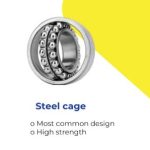Bearing clearance plays a pivotal role in ensuring optimal functionality, longevity, and efficiency of its applications. Let us understand the significance of bearing clearance, exploring its definition, types, impact on functionality, influencing factors, and its tailored applications across diverse industries.
What is Bearing Clearance?
Bearing clearance is simply the intentional gap between the rolling elements (balls or rollers) and the inner and outer raceways of a bearing. If you have ever seen a bearing up close you will notice that there are deliberate spaces between the balls and the raceways of the bearing. This is the bearing clearance area. Based on the type of clearance, bearing clearances can be broadly divided into:
- Radial Clearance: The clearance occurs along the radial direction, allowing for expansion or contraction of the bearing components. For example in a cylindrical roller bearing placed in the gearbox, radial clearance accommodates thermal expansion during operation.
- Axial Clearance: Axial clearance, also termed as endplay, is the axial movement of the bearing components, which prevents axial binding. Example: thrust ball bearing in a vehicle transmission will have an axial clearance that accommodates axial thermal growth.
What is the Impact of Bearing Clearance on Functionality?
- Load Distribution: Optimal bearing clearance ensures even load distribution. This in turn prevents excessive stress on specific components. For example, a tapered roller bearing placed in a wheel hub needs proper clearance to balance load distribution during cornering.
- Temperature Management: Bearing clearance influences temperature by allowing for thermal expansion. This in turn prevents overheating during an application. For example, a deep groove ball bearing in an electric motor can control temperature through proper clearance for prolonged motor life.
- Noise and Vibration Levels: Appropriate clearance minimizes noise and vibration, providing smoother and quieter operation. Imagine a spherical roller bearing in a conveyor system, where optimized clearance contributes to a quieter material handling process.
What are the Factors Influencing Bearing Clearance?
- Operating Conditions: The environment in which a bearing operates influences the required clearance, considering factors like temperature and load. For instance a needle roller bearing in an industrial oven conveyor with high-temperature conditions necessitates customized clearance adjustments.
- Material Properties: The material properties of the bearing components have a direct impact on thermal expansion, and therefore the optimal level of clearance. For example, a self-aligning ball bearing in a printing press will have a clearance based on the property of the material that influences the expansion and contraction dynamics.
- Application-Specific Requirements: Different applications demand specific clearance adjustments to meet performance and durability criteria. For instance, clearances for spinning mills depend on the unique operating conditions of each textile.
Applications Across Industries: Tailoring Clearance to Specific Needs
- Automotive Industry: These applications require precise clearance adjustments to accommodate dynamic conditions for optimal performance.
- Aerospace Industry: Aerospace applications demand meticulous clearance control to meet stringent performance and safety standards.
- Heavy Machinery: These will mandatorily follow a customized clearance adjustment to manage substantial loads.
In essence, the importance of bearing clearance extends far beyond its seemingly subtle presence, influencing the very core of machinery functionality. This shows the importance of the intricate balance required for machinery to operate seamlessly in diverse and challenging environments.
FAQ's
How is bearing clearance different from other dimensions in bearings?
Bearing clearance is distinct since it refers to intentional space, crucial for accommodating thermal expansion and ensuring proper functionality. This is a functional dimension that will differ based on application needs.
Why is temperature management important in relation to bearing clearance?
Temperature management is vital in case of bearing clearance, based on application and load because:
- It prevents overheating,
- Maintains lubrication effectiveness, and
- Contributes to the bearing’s overall longevity.
How does bearing clearance influence noise and vibration levels in machinery?
Appropriate bearing clearance minimizes friction-related noise and vibration. This by default ensures a smoother and quieter machinery operation.
What factors influence the choice of optimal bearing clearance in different applications?
Operating conditions, material properties, and application-specific requirements are key factors influencing the choice of optimal bearing clearance.
How often should bearing clearance be checked and adjusted?
Regular maintenance schedules should include periodic checks and adjustments to bearing clearance, ensuring consistent and reliable performance.



















